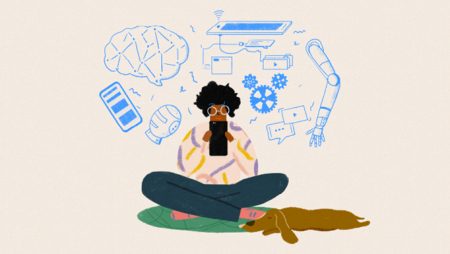What is AI?
Put simply, AI is the ability of a digital computer or computer-controlled robot to perform tasks commonly associated with intelligent human beings. For many people, AI is an alien concept, something which might happen in the future, a dystopian view of the world as the machines take over and robots replace people in the workplace. Yet the truth is very different. AI can be harnessed as a force for good and have a positive impact on our lives and our wider society.
AI is already making a real difference in our everyday lives, whether helping us with our entertainment choices, finding us our dream job or online shopping tips, it’s very much a factor of the here and now. But for AI systems to work for society, we still have a way to go to ensuring that they are fair and unbiased. As internet scholars at the forefront of interdisciplinary research into the ethics, governance and impact of AI, we have an important role to play in helping to shape the regulatory framework behind the implementation of AI systems, ensuring AI works for everyone.
Public perceptions of AI
With so many myths and misconceptions surrounding AI, we commissioned a YouGov survey of 2,000 people in Britain to help understand a little more about peoples’ perceptions of AI. The results make interesting reading. The findings show just over a quarter of people, 26%, thought they were already using AI and over a third of people, 37%, had concerns about using AI in everyday life. Yet when it comes to the bigger picture, an overwhelming 92% of people said they see the long-term potential for AI to help others, with just 8% of Brits saying AI has no role to play in tackling wider social and economic issues in the future.
It’s encouraging to see that people can see the benefits of using AI tools and services to help tackle some of the big challenges we face as a society such as climate change, extreme weather and improving transport and healthcare systems. In particular, as countries across Europe work to contain the coronavirus pandemic, the findings show that people understand the positive role AI can play in transforming healthcare, with 46% of people agreeing that AI could help healthcare professionals diagnose illnesses and 34% of people acknowledging that AI could also help them prioritize who treat. The findings also show that Brits don’t fear automation in the healthcare sector, with 43% of those surveyed seeing the benefits of automating certain routine administration tasks such as processing prescriptions, enabling front line staff to focus their efforts on those with the greatest needs.
Yet when it comes to their own lives, Brits have some concerns about trusting AI with important decisions. However, AI is already being adopted by governments, local authorities and industry in ways that can help us all in our daily lives, without, as our survey shows, many of us even realising. What this suggests is that we all have a lot of work to do in connecting today’s AI reality with people’s ability to participate in the fast-moving conversations about how, when and where we want AI used in our everyday lives.
Role of academics in shaping public understanding of AI
As academics, we have a role to play in helping demystify some of the common public misperceptions around AI and leading conversations about how ensuring AI can benefit individuals and the wider society. We do this by partnering with external stakeholders, such as industry, consumer groups, community organisations or charitable foundations, which enables us to extend the reach of our work beyond academia and reach a global audience.
We’re proud to partner with Google to create The A-Z of AI, a series of simple, bite-sized explainers to help anyone understand what AI is, how it works and how it’s changing the world around us. Together, we curated AI content to develop an online resource that helps people distinguish AI fact from fiction and get to grips with what can be a complex topic.
As the OII’s latest public education project, The A-Z of AI draws upon the expertise of students across the OII, notably Blake DiCosola, Maggie McGrath and Jay Ward, whom all share a common interest in educating people about the potential of AI.
Snapshot of the A-Z of AI
There’s a wealth of information for those wanting to find out more, here’s a few of the things you might learn:
You’ve probably interacted with AI without even realising it. If you’ve ever searched for a specific image in Google Photos, asked a smart speaker about the weather or been rerouted by your car’s navigation system, you’ve been helped by AI. Those examples might feel obvious, but there are many other ways it plays a role in your life you might not realise. AI is also helping solve some bigger, global challenges. For example, there are apps that use AI to help farmers identify issues with crops. And there are programs that juggle huge amounts of live flight data, enabling airlines to plan more efficient flight paths and maximise cargo space to reduce carbon emissions.
AI offers us the ability to process large volumes of data and uncover patterns—an invaluable aid when it comes to climate change. One common use case is AI-powered systems that help people regulate the amount of energy they use by turning off the heating and lights when they leave the house. AI is also helping to model glacier melt and predict rising sea levels so effective that action can be taken. Researchers are also considering the environmental impact of data centres and AI computing itself; for example, exploring how to develop more energy efficient systems and infrastructures.
Just as a child learns through examples, the same is true of machine learning algorithms. And that’s what datasets are: large collections of examples, like weather data, photos or music, that we can use to train AI. Due to their scale and complexity (think of a dataset made up of extensive maps covering the whole of the known solar system), datasets can be very challenging to build and refine. For this reason, AI design teams often share datasets for the benefit of the wider scientific community, making it easier to collaborate and build on each other’s research.
“Deepfakes” are AI-generated images, speech, music or videos that look real. They work by studying existing real-world imagery or audio, mapping them in detail, then manipulating them to create works of fiction that are disconcertingly true to life. However, there are often some tell-tale signs that distinguish them from reality; in a deepfake video, voices might sound a bit robotic, or characters may blink less or repeat their hand gestures. AI can help us spot these inconsistencies.
As smart as AI is (and will be), it won’t be able to understand everything that humans can. In fact, you could give an AI system all the data in the world and it still wouldn’t reflect, or understand, every human being on the planet. That’s because we’re complex, multidimensional characters that sit outside the data that machines use to make sense of things. AI systems are trained and guided by humans. And it’s up to each person to choose how they interact with AI systems and what information they feel comfortable sharing. You decide how much AI gets to learn about you.
For twenty-two more definitions, visit the A-Z of AI.
Professor Gina Neff’s research can be found here.
Watch Professor Neff deliver the OII London Lecture, ‘Does AI have gender’.
Read Professor Neff’s keynote address at the AIES AI, Ethics and Society conference 2020.
Read Neff & Nagy paper, ‘Talking to Bots’.

